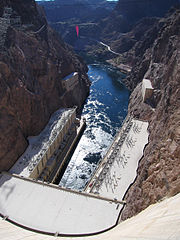Obama is Wrong about the Hoover DamDouglas FrenchJul. 19, 2012 |
Popular 
Sen. Hawley: Send National Guard to Crush Pro-Palestine Protests Like 'Eisenhower Sent the 101st to Little Rock'

Mistrial Declared in Case of Arizona Rancher Accused of Killing Migrant Trespasser

AP: 'Israeli Strikes on Gaza City of Rafah Kill 22, Mostly Children, as U.S. Advances Aid Package'

John Podhoretz Demands National Guard Be Sent Into Columbia U to Put Down Pro-Palestine Protests

House Passes $95B Foreign Aid Giveaway to Israel, Ukraine and Taiwan, Combined With TikTok Ban
  In his famous "you didn't build it" speech, President Obama cited the Internet, fire departments, the GI Bill, the Golden Gate Bridge and the Hoover Dam as examples of government action that helps business owners. In his famous "you didn't build it" speech, President Obama cited the Internet, fire departments, the GI Bill, the Golden Gate Bridge and the Hoover Dam as examples of government action that helps business owners.Each needs addressing, but let's start with the Hoover Dam. The president is riffing off of Rachel Maddow's MSNBC commercial in which the TV pundit dressed in her best black T-shirt and hoodie, points up at Hoover Dam and says words to the effect that the dam reminds us that an individual can't build a dam — or a company, for that matter. It takes a country to build projects of this magnitude. Having a soft spot for environmentalism, it's surprising Maddow embraces the concrete monster. At the time, Hoover described the dam as “the greatest engineering work of its character attempted by the hand of man.” The massive structure cost $49 million (or $736 million in inflation-adjusted dollars) and measures over 726 feet in height and more than 1,200 feet in length. It took five years and 4,360,000 cubic yards of concrete to build, and was finished two years ahead of schedule. About 16,000 people worked on constructing the dam, with over 100 losing their lives in the process. There's nothing new about government throwing taxpayer money around to create jobs. The Romans constructed aqueducts in small towns, industrial sites and large cities from France to Istanbul. To construct the aqueduct of Segovia, Spain, Romans stacked massive bricklike granite blocks into a structure that reached a height of over 93 feet. Although no one knows for sure, it’s estimated that the aqueduct was constructed sometime during the reign of either Emperor Vespasian or Nerva to transport water from the Fuente Fria River over 10 miles from the city. The aqueduct has 167 arches and reaches its height at the Plaza del Azoguejo. The impressive Roman structure only serves to attract tourists to the city of 55,000 today. When I visited two years ago, our guide, Jerry, told us Segovia’s population did not warrant such an expenditure when it was built. “The Romans primarily built the aqueduct as a show of power.” Just as the Keynesian policies of the New Deal tried to cheat the laws of economics, government’s damming of the Colorado River attempted to cheat Mother Nature by bringing water to the desert southwest — water that just isn’t and never was there. The great Western explorer John Wesley Powell was booed out of the room when he told the Irrigation Congress, “Gentlemen, you are piling up a heritage of conflict and litigation over water rights, for there is not sufficient water to supply the land.” But 75 years ago, when the dam was nearly completed, FDR proclaimed during his dedication speech that millions of present and future residents of the Southwest could count on “a just, safe and permanent system of water rights.” The turbulent Colorado River that vacillated between droughts and floods would be tamed and become “a great national possession,” and be counted on for irrigation to support a human migration seeking mild winters and new opportunities. “The nation took him at his word,” writes Michael Hiltzik, author of Colossus: Hoover Dam and the Making of the American Century. “Since that dedication year, the population of the seven states of the basin has swelled by about 45 million. Much of this growth has been fueled by the dam and its precious bounties of water and electrical power.” As Hiltzik points out, the dam’s water promise gunned the growth of Southern California cities and attracted farmers to the West to grow water-intensive crops like cotton, despite the lack of normal rainfall required to support this kind of agriculture. Just as government stimulus programs and artificially low interest rates that promise to spur growth and make up for the lack of private investment never work, Hoover’s promise that his dam would, as Hiltzik writes, “provide all the water their states could conceivably need to fulfill their dreams of irrigation, industrial development and urban growth” is literally drying up. The water level at Lake Mead is down nearly 100 feet from its high water mark, revealing a white “bathtub ring.” According to Wikipedia, the lake's water volume is just slightly half the amount the lake could hold at its maximum. Now that millions have migrated to the Southwest and private industry has invested millions of dollars, Hoover's and FDR’s promises have confined those living and doing business in the West “in the straitjacket of an ever-intensifying water shortage,” notes Hiltzik. And while Interior Secretary Gale Norton claimed to have stilled the “conflict on the river” back in 2003 with the signing of two dozen agreements transferring water rights between various Indian tribes, cities and governments, the battle for water will rage on. The supply will never catch up with the demand. After the 10-year drought, an additional intake pipeline into the diminishing Lake Mead is being installed. Almost 90% of the drinking water for Las Vegas comes from the lake. The new intake pipeline, officially known as Intake No. 3, “will reach deeper into the reservoir to protect the valley’s water supply, should the lake shrink low enough to shut down one of the two shallower straws,” reports the Las Vegas Review-Journal. The project targets 2014 for completion. "This new intake tunnel is 3 miles under Lake Mead, and then there is a tap of the lake about 3 miles out. I like to say it's as if you've got your bathtub full of water, and now we are putting the drain into it while it's full," says Vegas Tunnel Constructors (VTC) Vice President of Operations Jim McDonald. The contract amount started at $447 million, but the cost has risen by over $100 million since the project began. The tunnel, after excavated for the pipeline, unexpectedly filled with water three times in the project's first six months. Last month, excavation was delayed again when a VTC worker was killed 600 feet below ground when one of the tunnel segments was jarred loose, and pressurized grout was discharged, striking two of the workers. Those in government never learn. They can’t print prosperity, and more water won’t magically appear if they dam a river. While the man on the street believes government infallible, politicians and bureaucrats cannot calculate the economic profits and losses of government interventions. Governments will forever fight over scarce water, and private use is increasingly being restricted by local ordinances. “The spending for nonproductive public works, for the bureaucracy and for the Army led to excessive taxation, inflation and the ruin of the essential middle class and its leaders,” H.J. Haskell wrote in his book The New Deal in Old Rome, destroying the men French historian Leon Homo called “the general staff of civilization.” The New Deal dam project that Obama and Maddow are so proud of provided a few thousand jobs 80 years ago, but has spurred migration, farming and development that is likely unsustainable and may ultimately be, like the aqueduct in Segovia, just a giant tourist attraction. This is something future tourist guides will call "an example of American government power." _ Douglas E. French is senior editor of the Laissez Faire Club. He received his master's degree under the direction of Murray N. Rothbard at the University of Nevada, Las Vegas, after many years in the business of banking. He is the author of two books, Early Speculative Bubbles and Increases in the Supply of Money, the first major empirical study of the relationship between early bubbles and the money supply, and Walk Away, a monograph assessing the philosophy and morality of strategic default. He is founder and editor of LibertyWatch magazine. Write him. |



